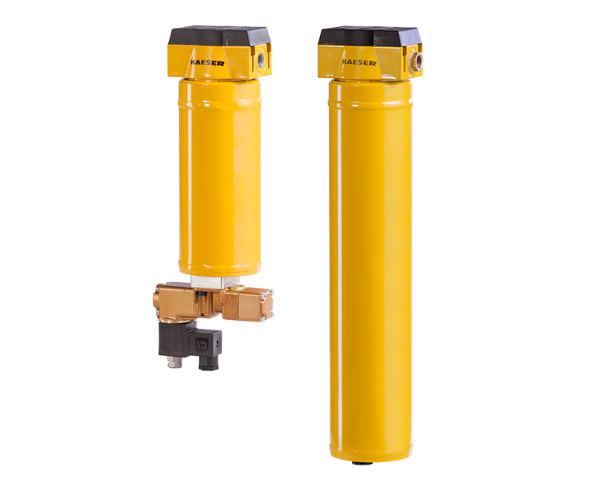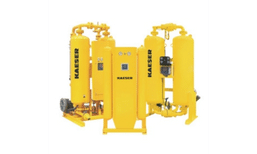

Membrane Dryers
Membrane dryers are an ideal solution when electrical power is unavailable or prohibited. These dryers are designed for low CFM flows making them ideal for point of use applications, or tight spaces.
Compact and robust, membrane dryers function by passing compressed air through hollow fibre permeable membranes that selectively remove water vapor molecules, suppressing the dewpoint of compressed air in the minus temperature range. Capable of delivering PDP’s from +10°C to −40°C, dew point suppression is relative to the inlet air temperature.
Did you find what you were looking for?
The system
Kaeser Modular Membrane (KMM) dryers provide a simple and reliable way to dry compressed air to dew points as low as -40°F and reduce maintenance costs. KMMs keep moisture from ruining paint jobs, clogging sandblasters, and fouling pneumatic instruments, valves, and controls.
1-Compressed air inlet
2-Membrane fibre module
3-External casing
4-Purge air nozzle
5-Purge air outlet
6-Compressed air outlet

Frequently asked questions
What is the function of a membrane dryer?
A Membrane Dryer uses a permeable membrane allowing water vapour to pass through it. Compressed air is restricted from permeating the membrane and therefore, is delivered to the application free of liquid water and vapour.
What is the dew point of a membrane air dryer?
Membrane dryers rely on inlet compressed air and ambient conditions, which dictate the dewpoint of the compressed air exiting the dryer. In a well engineered membrane dryer application, dewpoints as low as minus 40° can be achieved.
What to look for when buying a dryer?
As with most things, we typically get what we pay for. There are low cost offshore dryers in the marketplace, but these often arrive in Ontario unsuitable or certified for use in this province, because TSSA and CRN have requirements for pressure vessels.
Should a Membrane Dryer be installed with a pre-filter?
Yes, absolutely. The Membrane Dryer should be protected by a good quality pre-filter from particulates and oil. Ensure that your pre-filter includes a reliable and robust automatic condensate drain trap.
What is the difference between a membrane dryer and a desiccant dryer?
A membrane dryer does not regenerate itself. It's a single pass design and dewpoints fluctuate when ambient conditions alter. A desiccant dryer with twin towers, will regenerate itself by virtue of timed valves, or pressure dewpoint. The dewpoint is more reliable from a twin tower dryer, which is being serviced correctly.
How it works
Our tried-and-tested approach to get you a reliable compressed air solution at the lowest possible cost of ownership looks like this:

Discovery call
Our solutions specialist visits your facility to discuss your current situation, pain points, future plans, and potential government incentives. We can undertake as little, or as much, of your project as you would like.

Requirement analysis
We analyze the compressed air equipment at your facility, its performance, condition, control mechanisms, and suitability. We ensure that storage, piping, and compressed air quality are in line with your requirements and best practices.

Turnkey design and installation
Everything we do is “in house.” Compressed air system design, air audits, leak detection, design, build, installation, and air compressor service are handled quickly and efficiently. This approach means that we manage every aspect of your project and create single source supply for you and your organization.

Maintenance and repair
Whether you require emergency breakdown response, predictive, or preventative maintenance our team has you covered. Air end and motor service and rebuilds, piping system, and analysation are also available.


